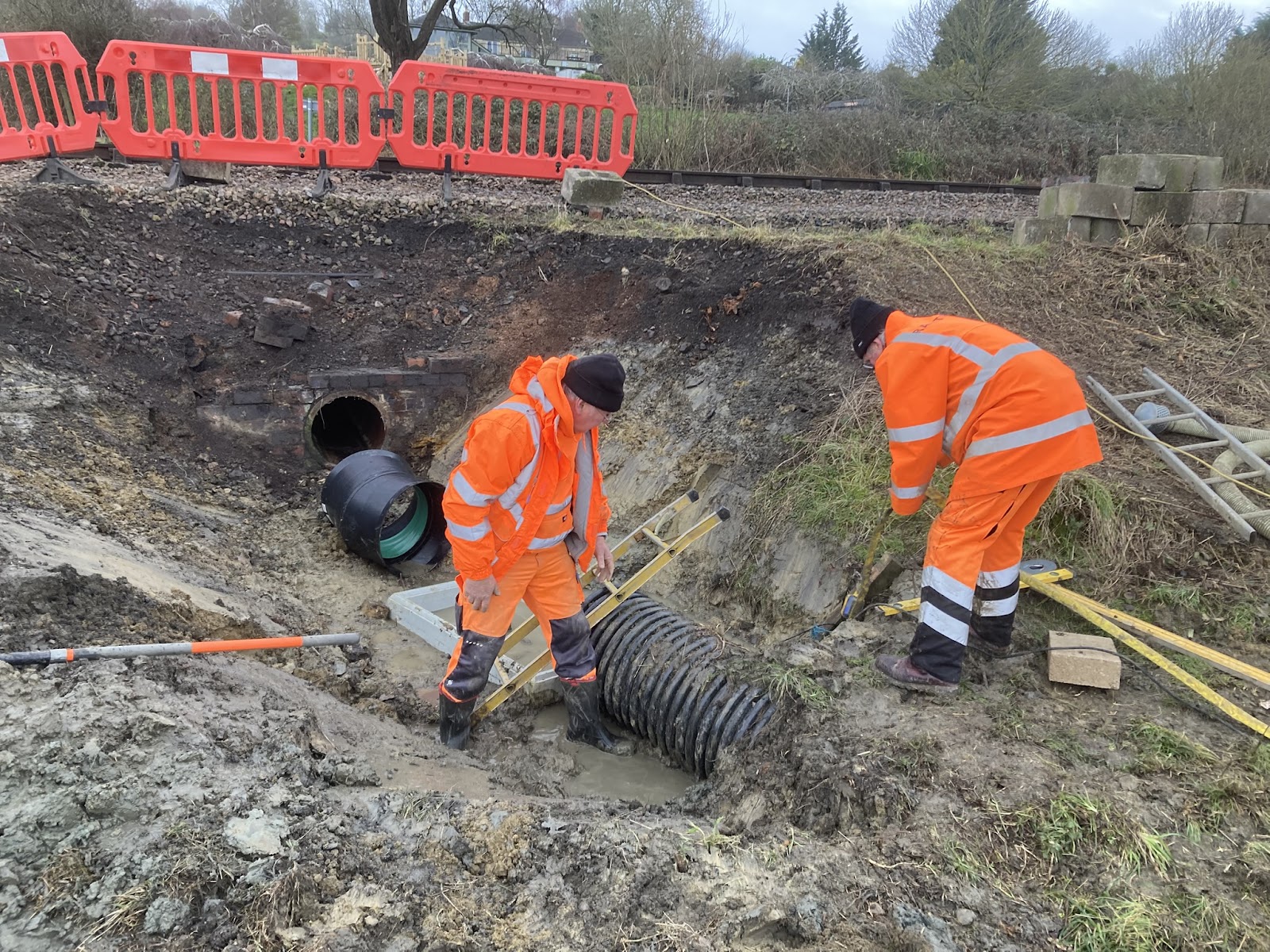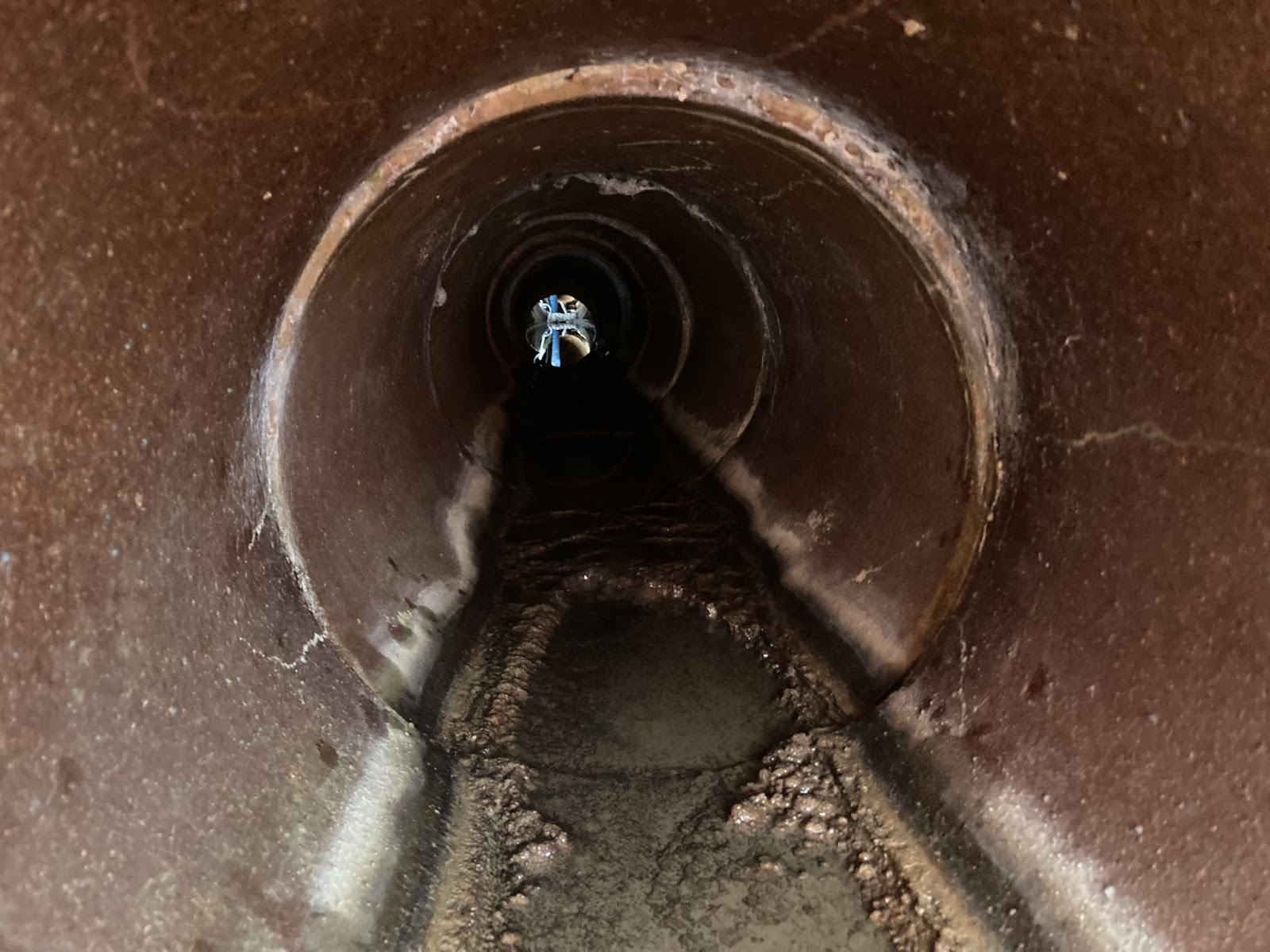A common misconception is that we in the Drainage team spent every working day in chambers or ditches, getting wet and dirty excavating silt and mud. This is far from the truth! However, occasionally there are days when that does apply, the fourth week of January was one. At least for some of the team.
Thursday 23rd January
Eight of the team in attendance, all occupied with one task – the rebuilding of the main outlet of culvert 24A opposite the Royal Oak at Gretton. Hence it was a convoy of three vehicles that set off from Winchcombe Yard, with the blue LWB tail-lift transit laden down with tools and materials. We had not used some of the tools, such as the cement mixer, the portable generator, and the submersible pumps for several weeks. So these all required checking before we set off.
The first job on site was to pump out the pond between the under tack bore and the under haul road pipe; also to pump out the inlet chamber on the down side to prevent water flowing through the bore. The main source of water is through the down side low mileage cess drains that run back to Greet tunnel, but there was also some flow from the stream that enters from the bottom of the pub garden. Nigel was chief pump operator (well qualified as a former firefighter). Once the water level was low enough, Roger and Andrew donned wellingtons to enter the pool to determine the exact location of the new chamber and to measure the lengths of the 450mm twinwall pipe to be added. Once the pipe lengths were determined, Jonathan and Peter headed back to Winchcombe to cut the 6m length of pipe to size and bring it back to site.
 |
| Submersible pump inserted into the down side inlet chamber of 24A. |
 |
| Roger (left) in the pond and Nigel establishing the position of the new chamber. Its size is dictated by the GRP catchpit ring just behind Roger. |
Meanwhile, Dave, Martin and Ian undertook some landscaping of the surrounding area. After removing logs, tree stumps and old sleepers from the remaining area of scrub between the top of the haul road and the vacant up side track bed; this was brush cut. They stacked the logs by the boundary fence; the old sleepers were placed on the downhill edge of the haul road and the tree stump remains went to a compost pile. They also cleared the outlet ditch of 24A downstream of the haul road. Over the years this ditch has scoured quite a deep course. So some recovered mostly broken concrete slabs were placed in this ditch as anti-scouring material. With no water flowing through the culvert, this task was much easier. More like laying a crazy paving path.
 |
| Martin recovering another old sleeper from the area between the top of the haul road and the vacant track bed where the up line was. |
 |
| Logs piled near the boundary fence to create a wildlife habitat for insects and small mammals. |
 |
| Not a crazy paving path! Broken slabs in the bottom of the 24A outlet ditch to prevent more downcutting. John and Dave clearing by the boundary hedge. |
With the position of the new chamber marked, Nigel mixed some mortar using rapid drying cement. This does dry very rapidly, so the best method is to mix just a bucket load at once by hand. Roger was on block laying duty; with Andrew bailing out the hole and attempting to remove as much silt and mud as possible. By lunch time, the first course of blocks were laid.
 |
| Half of the first course of blocks laid; water on the left shows the edge of the concrete base which we laid in 2019. |
 |
| The tricky first course of blocks for the new chamber completed. New 450mm twinwall pipe, elbow bend and a GRP catchpit ring in the background. |
 |
| A view from the down side outlet through the bore of 24A. In a few weeks time the only way to get a shot like this will be with a remote CCTV unit. |
Unlike the past three weeks, lunch was
on site rather than in the Churchward House Mess. Certainly not
al-fresco, as a short sharp heavy shower of rail came through. After
lunch, we trial fitted the new length of 450mm twinwall pipe;
checking for vertical as well as horizontal position. As this will
need to sit on the second course of blocks of the new chamber; we did
not fit it. We also decided to let the mortar for first course of
blocks to fully harden – so we will add the subsequent courses next
week. Hence after lunch the team spent some time tidying the site;
removing broken bricks from the excavated infill and keeping an eye
on the pumps. The last thing before heading back was to turn the
pumps off – and within five minutes water was flowing through the
main bore. Hence the first job next week will be to pump this out
again.
Wildlife report: Evidence of another mammal was spotted near the top of the haul road – moles. There were several piles of nice fine soil in tell tail mole hill shapes. No sign of any mice today – after watching BBC-tv Winterwatch, some of the team think that last weeks sighting was a wood mouse not a field mouse. There certainly are plenty of small mammals around, as in the sky we spotted Red Kites, Buzzards and a Kestrel. Another Red Kite was circling very low over platform 2 at Winchcombe; whilst one member reported a sighting of a Peregrine falcon on his journey home.

No comments:
Post a Comment